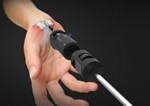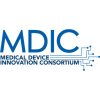Innovation in medical devices is often driven by surgeons with firsthand experience in the operating room or by professionals who work closely with such surgeons and have direct insight into their needs. The development of the Stratos™ surgical tool for endoscopic carpal tunnel release surgery began with A.M. Surgical’s president Romi Mirza, son of hand surgeon and company founder Ather Mirza, recognizing the opportunity to streamline carpal tunnel release surgery by creating an all-in-one tool.
The opportunity
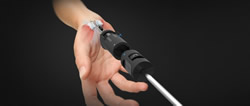 Carpal tunnel syndrome affects millions. In this painful and often debilitating condition, the median nerve is compressed in the narrow canal between the bones of the wrist and the ligament at the base of the palm. Surgeons treat carpal tunnel syndrome by dividing this ligament to relieve pressure on the nerve.
Carpal tunnel syndrome affects millions. In this painful and often debilitating condition, the median nerve is compressed in the narrow canal between the bones of the wrist and the ligament at the base of the palm. Surgeons treat carpal tunnel syndrome by dividing this ligament to relieve pressure on the nerve.
A.M. Surgical advanced this procedure with the Clear Cannula, which allows a clear view of the surgical field while protecting structures including the median nerve, and the surgical scope-mounted blade, which further optimized the treatment.
Despite these advancements, the procedure as a whole was still cumbersome. Introducing the cannula required using a secondary tool to advance it into the carpal tunnel. This was done blindly and at times would require multiple attempts to correctly position the cannula within the tunnel. Furthermore, application of the scope-mounting blade onto the scope required the assistance of OR staff leading to increased steps and inefficiencies.
Iterate, iterate, iterate
Romi Mirza was passionate about solving these problems to enable faster, safer, and more effective surgery, and began working with the Carbon Design Group early in the process to develop an all-in-one tool that would streamline the procedure.
 Once the design and development team was up to speed on the surgery and the existing tools, concepts were quickly generated, prototyped, and tested. Low fidelity prototypes were developed in-house in order to quickly prove, disprove, or refine approaches.
Once the design and development team was up to speed on the surgery and the existing tools, concepts were quickly generated, prototyped, and tested. Low fidelity prototypes were developed in-house in order to quickly prove, disprove, or refine approaches.
Extensive cadaver studies were conducted throughout the development process. Our team gained first-hand knowledge by working alongside the A.M. Surgical team testing prototypes. By having hands on experience using the device with cadavers, the team was able to more deeply understand the force loads, and hand positioning involved in using the device. Some of these observations led to mid-procedure modifications which could immediately be retested. In addition, surgeons were observed in order to see how experts seeing the device for the first time would react to and use the product. This highly-iterative approach allowed the team to quickly hone in on solutions.
A key for all of the collaborators in the development of Stratos was to be open-minded throughout the creative process. It was essential to not be held back by supposed design limitations and instead tackle each of the desired product requirements with the belief and determination that it can be done, all the while keeping sourcing, manufacturing, and assembly considerations in check.
Making it real
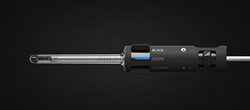 Ultimately, the final design included a handle with two sections: The front section stores both the scraper and blade attachments, while the back section locks onto the endoscope, and is attached to the front housing by a metal tube. The endoscope is introduced through the rear of this section and slipped through the metal tube. At the front end of the metal tube, there is a metal tab that enables attachment of the blade and scraper.
Ultimately, the final design included a handle with two sections: The front section stores both the scraper and blade attachments, while the back section locks onto the endoscope, and is attached to the front housing by a metal tube. The endoscope is introduced through the rear of this section and slipped through the metal tube. At the front end of the metal tube, there is a metal tab that enables attachment of the blade and scraper.
One challenge was to engineer a mechanism for the back section of the handle that allowed for 360 degrees of rotational movement, yet would hold its fore/aft position unless the surgeon pressed a button allowing movement. The solution was a mechanism created from three simple, stamped metal parts—two plates with holes in them, and a return spring. It works in a fashion similar to a finger trap. The harder you push or pull, the tighter it holds its position unless the button is pushed, activating the spring mechanism to allow forward or backward movement.
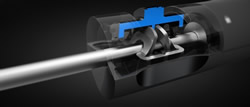 The front section of the handle is where the real procedural innovation is enabled. Housed within this section are the scraper and blade attachments. A paddle switch can be in one of three positions, Scraper, Scope, or Blade. To change tools, the surgeon pulls the endoscope back, and flips the paddle. The selected tool is deployed and the surgeon maintains a clear view while advancing the endoscope to scrape, cut, or view the ligament. The tool is automatically returned to the revolver when the endoscope is pulled back again. The simplicity of the mechanism that accomplishes this means manufacturing and assembly costs are kept low.
The front section of the handle is where the real procedural innovation is enabled. Housed within this section are the scraper and blade attachments. A paddle switch can be in one of three positions, Scraper, Scope, or Blade. To change tools, the surgeon pulls the endoscope back, and flips the paddle. The selected tool is deployed and the surgeon maintains a clear view while advancing the endoscope to scrape, cut, or view the ligament. The tool is automatically returned to the revolver when the endoscope is pulled back again. The simplicity of the mechanism that accomplishes this means manufacturing and assembly costs are kept low.
The magic is in the details
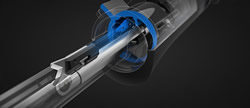 The final product is an all-in-one device that includes the clear cannula and a handle that provides increased leverage and keeps the scraper and blade poised for deployment. This configuration is functional for both the distal and proximal, single-port approaches. The new device greatly reduces the number of steps in the surgery and increases efficacy.
The final product is an all-in-one device that includes the clear cannula and a handle that provides increased leverage and keeps the scraper and blade poised for deployment. This configuration is functional for both the distal and proximal, single-port approaches. The new device greatly reduces the number of steps in the surgery and increases efficacy.
A key innovation in the procedure is that once the Stratos cannula is introduced into the patient, the Stratos/endoscope combination never leaves the body. This keeps the cannula in the optimal position at all times. From insertion to exit, the surgeon has complete vision of the surgical. The incorporated fulcrum on the front edge of the handle provides leverage when introducing the cannula. Form and materials guide the surgeon to during use. High polish touch points and purposeful forms work together to make an intuitive product.

The interactions and mechanisms were developed simultaneously, resulting in a design naturally optimized for both manufacturing and assembly. The individual parts are engineered to be efficient, resulting in production costs that make the device a profitable addition to the A.M. Surgical line. The prototyping vendor, Model Solution, was chosen to manufacture the device, allowing a seamless transition from development to full production.
The development of the Stratos all-in-one disposable medical device, can serve as a guide to surgeons and medical professionals who see opportunities to improve surgeries through medical device development. Swift, frequent prototyping and testing combined with tightly integrated design and engineering can help guide your project from opportunity identification, through market release.
About Carbon Design Group
Carbon Design Group is a full-service product design and development consultancy. We partner with forward looking companies to envision and create industry leading products. Based in Seattle, Washington, Carbon delights clients by blending insightful research, thoughtful design, and end-to-end engineering expertise. Our holistic approach minimizes risk, speeds time to market, and delivers results that resonate. Carbon is widely recognized for innovation and for the development of iconic product families. Our portfolio of clients includes GE, Intel, Medtronic, Microsoft, Panasonic, Philips, Xbox, and many more.
About A.M. Surgical, Inc.
A.M. Surgical, Inc. develops and markets minimally invasive surgical devices for the upper extremity surgeon. Founded by Ather Mirza, MD in 1995, the company has maintained his vision of developing surgical products that are intuitive in design, improve patient outcomes and offer economic solutions for the surgeon and healthcare facility. The company is headquartered in Smithtown, New York.

